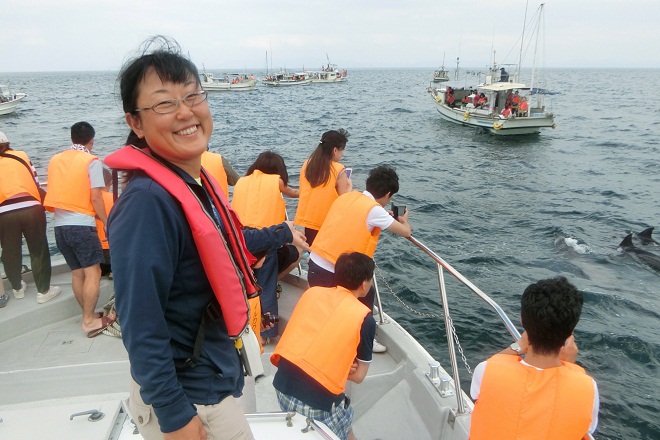Woman Eyes Sustainable Dolphin Leisure in Amakusa
August 26, 2018
Amakusa, Kumamoto Pref.- Hiromi Takasaki, a 40-year-old nurse from Tokyo, has loved dolphins for as long as she can remember.
While in high school, she learned about the aquatic mammal in a program at the Dolphin Research Center in the U.S. state of Florida. She has since enjoyed dolphin watching in various places at home and abroad, including islands off the Izu Peninsula, central Japan, the Bahamas and Hawaii.
When she visited Tsuji Island, a tiny island in Amakusa, Kumamoto Prefecture, southwestern Japan, in 2015, she was stunned.
"Almost every time you go dolphin watching here, you can see wild dolphins right after the boat sails into the ocean," she says. "There's no other such place in the world."
Last year, charmed by the dolphins, Takasaki moved to the island, which has a coastline of about 4 kilometers, some 550 residents and is known for fisheries.
Last month, Takasaki set up a research center on the island, Amakusa Dolphin Lab, which she hopes will be a base for dolphin research and tourism promotion, with seven other people, including dolphin-watching tour operators and technology experts.
The goal of the laboratory is to realize sustainable dolphin leisure activities.
Nearly 200 Indo-Pacific bottlenose dolphins are believed to live in waters off Tsuji Island. Dolphin-watching tours with high chances of encountering dolphins are already popular here, drawing about 80,000 tourists a year.
But Takasaki, who now works as a guide for dolphin watching, thinks the current format of such tours, with tourists just watching dolphins, doesn't capitalize on the full potential.
"More tourists will keep coming back if you give lectures about how dolphins live in the area in advance or include dolphin watching in tours that take tourists to local islands," she says.
Amakusa Dolphin Lab plans to launch a year-round survey to identify dolphins in the area individually, understand how many dolphins actually live in the area and monitor how the number changes.
Photos are normally used to identify dolphins by the shape of their dorsal fins. The laboratory, however, is considering using software that shoots video with a camera installed on the boat and automatically identifies dolphins.
Currently, there are no clear agreements about dolphin watching, including how close boats should approach them. As many as 10 boats may chase the same group of the creatures, drawing disapproving online comments.
To improve the status quo, the laboratory is planning to compile guidelines for tour operators and train guides, on the basis of the outcome of its planned survey.
"On Tsuji Island, fisheries typically involve fishermen diving to harvest marine products. They haven't treated dolphins as a nuisance and coexist with them," Takasaki points out.
"Through the lab, I want to show Amakusa to the world as a special place where nature and human beings can live in harmony," she says. Jiji Press
Latest Videos
- THE UNTOLD STORY EXPERT INSIGHTS INTO THE UKRAINE
- NEGOTIATING A NEW ORDER US RUSSIA TALKS ON UKRAIN
- Ukraine: A Pawn in the Geopolitical Game? Will Trump Intervene?
- US VP VANCE CRITICIZES EUROPEAN DEMOCRACIES AT MUNICH SECURITY CONFERENCE
- UNCOVERING THE WEB OF DECEIT: CIA INFILTRATION OF THE MEDIA
- SHIFTING SANDS: TULSI GABBARD’S CONFIRMATION AND THE EVOLVING GLOBAL LANDSCAPE
- FAUCI SCANDAL: A THREAT TO GLOBAL HEALTH AND DEMOCRACY






